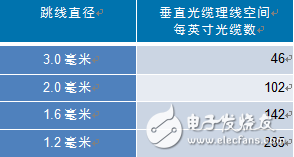The trend of micro-cables: smaller, faster, stronger
Smaller, faster, better – this is the trend of fiber optic cable for many years. With the invention of dispersion compensation technology and people's attention to issues such as improving fiber reliability, "faster and better" is undoubtedly the goal advocated in the 1990s.
In recent years, the industry has been focusing on reducing the footprint of fiber optic networks. It can be said that with the development of small bend radius (RBR) fibers by fiber suppliers around 2005, the trend toward smaller cables and hardware has begun to emerge. Shortly after the emergence of these new optical waveguide designs, an international standard was developed, the ITU G657. Subsequently, as the tolerance of the fiber to macroscopic bending and microbending increases, these fibers that can be "knotted" begin to allow for a smaller cable design.
Macro and micro benefits of small bend radius fibers
Macroscopic bending is a simple phenomenon that is easy to understand. The ITU G657 specifies special optical loss specifications at specific bend radii for macrobend performance. However, some claims that the microbend performance is improved from the main characteristics of the small bend radius to achieve smaller, higher performance wiring. One way to actually analyze the difference between macrobends and microbends is to imagine wrapping an optical fiber around your finger, measuring the fiber loss (macro bend), pressing a piece of sandpaper onto the fiber and measuring the corresponding Loss (microbend loss) and then compare the difference between the two.
In both cases, the fundamental optical phenomena that cause signal loss are very different. When the cable is exposed to a low temperature environment, the material in the cable will tend to shrink, applying a force along the length of the fiber. This force can cause microbends in the fiber within the cable. For example, an increase in the microbend tolerance of a small bend radius fiber can undoubtedly help the cable to withstand large temperature changes.
Global fiber optic cable manufacturers are using this feature of small bend radius fibers. Their "wish" is to develop fiber optic cables that can be used like copper cables - rugged, small, practical, easy for anyone to operate without damaging the fiber. To achieve this goal, people have also innovated the materials used in the manufacture of fiber optic cables. The bending performance of small bend radius fibers has been enhanced, facilitating the use of new materials and new manufacturing techniques in fiber optic cable manufacturing, resulting in smaller cable sizes and lighter weight. Together, these problems can be solved to create a new generation of fiber optic cables with smaller size and greater flexibility.
A major factor in small radius cables is patch cords and other straight-through cables. In addition to the obvious benefits of being able to install more fiber optic cables in the same space, smaller cable sizes can also speed up air flow because the cable takes up less pipe space. The importance of this advantage will become more apparent as active electronic component suppliers attempt to miniaturize and consolidate electronic cabinets. In such electronic cabinets, heat is becoming an important issue. Usually, people will consider the airflow along the copper cable (the copper cable itself generates heat). But as equipment cabinets get smaller and hotter, all aspects of airflow become important.
The new wave of smaller direct cable and jumper has been opened
Smaller size than your imagination
This phenomenon may not be as obvious now, but for every one unit of the diameter of the round cable, the space occupied by the cable (the area of ​​the circle) is correspondingly reduced. Therefore, a slight decrease in the diameter of the cable may mean that the footprint is greatly reduced. for example:

Therefore, comparing a typical 2.0-mm cable with a 1.2 mm diameter cable, it is clear that although the cable diameter is not reduced by half, the number of recommended cables that can be installed in the same space (1 square inch) is almost It is 3 times the original!
The China Red Sport Bluetooth Earphone is wear comfortable, sweat-proof headphones. True wireless design is more convenient in running, gym, walking.... Also long work time, even with portable charging case, give you longer music experience.
Red Sport Bluetooth Earphone,Wireless Sport Headphones,Wireless Headphones For Gym,Bluetooth Sports Headphones
ShenDaDian(China) Digital Electronics Co.,Ltd , http://www.btearbuds.com